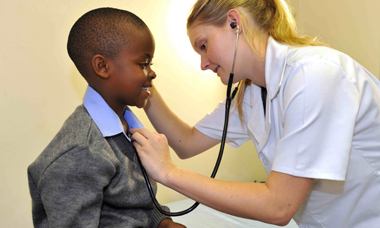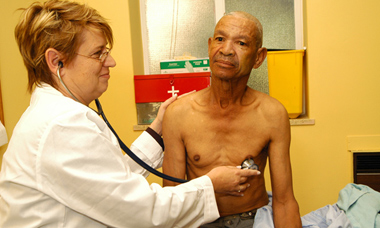News
Eight Things You Should Know About MDR Tuberculosis
Tuberculosis, or TB as it is generally known, affects millions of South Africans every year. However, Multi-Drug Resistant TB (MDR TB) is fast becoming more widespread. So it is important to be aware of the causes, diagnosis and successful treatment for this more aggressive form of TB.
 1) What is MDR TB?
1) What is MDR TB?
Multi-Drug Resistant TB (MDR TB) is a specific form of TB that does not respond to “ordinary” TB treatment. As a result it is difficult to treat and needs specialised treatment.
2) What Causes MDR TB?
MDR TB is caused by the development of TB bacteria, which have become resistant to ordinary TB drugs.
This occurs due to various reasons, including:
- As a result of inadequate or irregular management of "ordinary" TB - either by using inappropriate drug combinations or by using single drugs for "ordinary" TB.
- Being exposed to MDR TB by someone already infected, you can develop the same type of MDR TB.
- Persons not completing their routine TB treatment and having to restart on various occasions can also develop MDR TB. They are known as ‘defaulters’.
3) Who is at Risk of Contracting MDR TB?
People who are at greater risk of developing "ordinary" TB are also at greater risk for MDR TB. These include the following persons:
- Babies and children under 5 years of age (They will need to have treatment to prevent TB disease if exposed to someone with TB).
- HIV infected persons.
- Malnourished persons.
- Persons living in overcrowded households/ public institutions like prisons.
- Persons whose immune systems are not strong due to other diseases e.g. Diabetes Mellitus, cancer and some medications.
- Persons with substance abuse problems e.g. alcoholism or drug abuse.
4) What Are the Symptoms (Signs) of Persons with MDR TB?
The symptoms are the same as for "ordinary" TB, which include:
- Bad Cough for longer than three weeks either dry, yellow or green mucus and in some cases bloody mucus.
- Weight Loss.
- Fatigue.
- Shortness of Breath.
- Fever.
- Night Sweats.
- Lack of appetite.
- In children: the abovementioned signs inclusive of not gaining weight, coughing/wheezing for more than two weeks.
5) How is MDR TB Diagnosed?
Once a person presents with symptoms of TB, or is found to be a close contact of somebody with TB, clinic staff will request the person to provide two sputum (spit) specimens (phlegm from coughing), which will be sent to the laboratory for testing under a microscope.
A lab test, namely GeneXpert, will reveal whether you have TB, inclusive of Rifampicin resistance (one of the TB drugs causing MDR TB), within 12 – 48 hours of testing.
In addition to the normal tests done for TB, additional tests called culture and sensitivity testing are done on the sputum specimens of people suspected of having MDR TB.
These specialised tests take three to four weeks to reveal growth of the resistant TB strain, and to see which drugs will work against the bacteria. In addition, chest X-rays may be done in certain circumstances, to see the extent of any lung damage and for future monitoring of response to treatment.
6) Can Patients with MDR TB be Treated and Cured?
Yes, there are drugs that can be used to treat MDR TB provided you complete treatment under supervision. These drugs should be taken for a minimum of 18 - 24 months. If you have MDR TB you will have to receive daily injections for six months or longer.
MDR TB is more difficult to treat than ordinary TB, because the strain are resistant to the drugs used to treat ordinary TB. "Second line" TB drugs are used, which have more side effects.
If diagnosed early the chances of cure are much better. On average less than 50% people are cured due to high defaulter rate of approximately 40% of patients not completing treatment.
7) How is MDR TB Treated?
Patients with MDR TB will have to take at least 5 different drugs, including a daily injection for 6 months 5 days a week. Thereafter patients will need to take at least 4 different drugs for a further 12 – 16 months 7 days a week. Thus, treatment is much longer than for "ordinary TB" (which takes between 6 to 8 months), whereas MDR TB treatment can take up to 2 years and longer.
 8) How Can the Spread of MDR TB be Prevented?
8) How Can the Spread of MDR TB be Prevented?
When coughing or sneezing, any person and especially those with TB or MDR TB should cover the nose and mouth with a tissue to prevent air-borne spread of TB and MDR TB.
Patients should also avoid spitting into open air or on the ground. Good ventilation of households is strongly recommended, people are encouraged to keep all windows and doors open.
If possible limit prolonged contact (includes avoiding sharing the bedroom at night) with persons with ordinary TB or MDR TB, while their sputum remains positive with TB or MDR TB.
If this cannot be avoided, infectious patients are being encouraged to wear a mask when in close contact with other people, this includes when visiting health care facilities or any public places.
Even though the Western Cape has the highest TB cure rate in South Africa, the risk for new infections remains a serious challenge. More work is required to change behaviour and address misconceptions at an individual level, as well as efforts to address the more systemic and societal challenges.
To listen to the TB radio advertisement, click on the "play" button below.
English:
Bitter Pill
Commitment
Symptoms
Afrikaans:
Bitter Pill
Commitment
Symptoms
isiXhosa:
Bitter Pill
Commitment
Symptoms
For more information and medical advice, please go to one of your local primary healthcare Clinics, or visit the following TB Hospitals.


